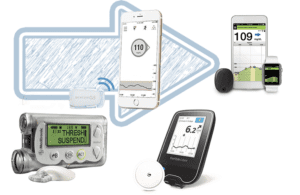 The rapid evolution of the continuous glucose monitor (CGM) has brought flexibility and convenience to diabetes control.
The rapid evolution of the continuous glucose monitor (CGM) has brought flexibility and convenience to diabetes control.
Continuous glucose monitors (CGMs) have transformed how many people with diabetes manage blood sugar, but attempts to monitor blood glucose have a long history.
Efforts to manage glucose kicked off in earnest when researchers began measuring glucose in urine in the mid-1800s. Scientists’ ability to do so steadily improved over the years, but urine glucose testing wasn’t commercialized until 1908, establishing a foundation for diabetes care.
Elkhart, Ind.–based Ames Company refined the process in 1945 with the introduction of Clinitest reagent tablets, which are still commercially available, albeit from Bayer. The company would introduce the first blood glucose test strip in 1965. The Dextrostix-branded strips were intended for use in doctors’ offices.
In the 1970s, Ames developed a device known as the Ames Reflectance Meter to measure reflected light from a Dextrostix strip. It was the first blood glucose meter and was intended for use in doctors’ offices.
Home blood glucose monitoring became feasible in the early 1980s with the launch of the Ames Dextrometer. This electronic glucometer allowed people with diabetes to check blood glucose in about one minute. More affordable blood glucose monitors would follow that require less blood than the Dextrometer.
While self-monitoring blood glucose technology continued to improve from the 1980s to the early 2000s, patient continuous glucose monitors didn’t become commonplace until the new millennium.